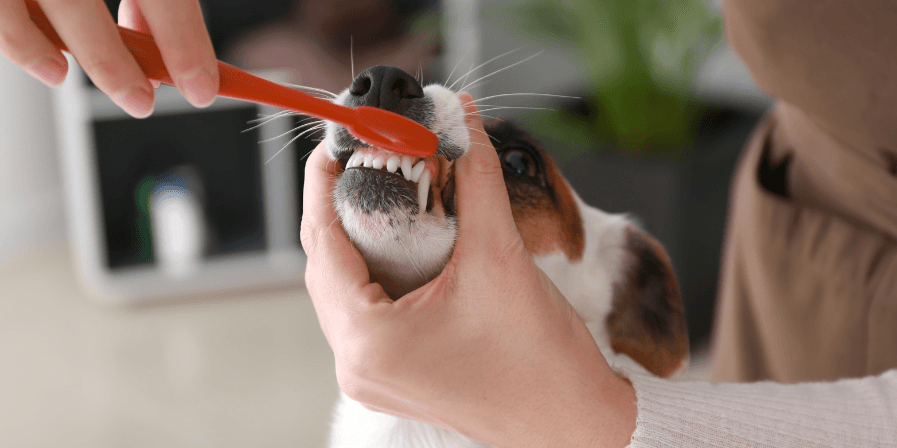Dog Teeth 101: From Puppy to Adult Dentition

A dog’s dental health plays a crucial role in their overall well-being, impacting their ability to eat, play, and interact comfortably. Just like humans, dogs go through different stages of dental development, from having baby teeth as puppies to developing a full set of adult teeth.
Understanding the structure and function of their teeth can help pet owners maintain their furry companion's oral health and prevent issues like tooth loss, infections, and gum disease. In this guide, we’ll explore how many teeth dogs have, the types of teeth they possess, and how to keep their pearly whites in top condition.
How Many Teeth Do Dogs Have?
Adult dogs typically have 42 permanent teeth, which is significantly more than the 32 teeth that humans have. These teeth are divided into different types, each with a specific function. A dog's upper jaw (maxilla) holds 20 teeth, while the lower jaw (mandible) contains 22 teeth. Each of these teeth plays a critical role in a dog's ability to chew, tear, and process food effectively. Unlike human teeth, which have flat molars for grinding, a dog’s teeth are designed more for cutting and crushing. This adaptation aligns with their carnivorous ancestry, although domesticated dogs now consume a mix of meat, kibble, and other processed foods.
How Many Teeth Do Puppies Have?
Puppies, like human babies, are born without teeth. Their first set of teeth, called deciduous teeth, start appearing between three to six weeks of age. These temporary teeth are often referred to as milk teeth or baby teeth, and they are much smaller and sharper than the permanent teeth that will replace them. By the time a puppy is about eight weeks old, they will have a full set of 28 baby teeth. These teeth include incisors, canines, and premolars, but no molars. Molars only develop once the permanent teeth come in. The teething phase can be uncomfortable for puppies, leading them to chew excessively on toys, furniture, or even their owner’s hands. To ease their discomfort, provide appropriate chew toys and avoid hard objects that could cause damage to their developing teeth. Between 12 to 16 weeks of age, puppies start losing their baby teeth as their adult teeth begin to emerge. By the time they are around six months old, most puppies will have their full set of 42 adult teeth.
Types of Dog Teeth and Their Functions
Dogs have four distinct types of teeth, each serving a specific purpose in their daily lives:
• Incisors (12 total): These small teeth at the front of the mouth help with grooming, scraping meat from bones, and grasping objects. Dogs often use their incisors to nibble at their fur to remove dirt and parasites.
• Canines (4 total): The long, pointed "fangs" are used for tearing and holding onto food. These teeth are essential for gripping and tearing apart meat, making them one of the most vital teeth in a dog's mouth.
• Premolars (16 total): Found behind the canines, premolars are responsible for shearing and slicing food. Dogs use these teeth to chew and break down food into smaller pieces before swallowing.
• Molars (10 total): Located at the very back of the mouth, molars help with crushing and grinding food. These teeth are particularly useful for chewing kibble and other hard foods.
Understanding these different types of teeth can help pet owners recognize potential dental issues and ensure their dog receives the proper care.
Can Dogs Lose Teeth?
Yes, dogs can lose teeth for various reasons, and while it is normal for puppies to lose their baby teeth, tooth loss in adult dogs is often a cause for concern.
Natural Tooth Loss in Puppies
As puppies grow, they naturally lose their baby teeth to make room for their permanent set. This process, known as exfoliation, usually begins around three months of age and continues until about six months old. Owners may notice missing teeth, blood spots on chew toys, or increased chewing behavior as their pup goes through this transition. In most cases, the baby teeth fall out on their own, but sometimes a vet may need to remove retained teeth that don’t shed properly.
Tooth Loss in Adult Dogs
Tooth loss in adult dogs is often a sign of underlying dental problems, including:
• Periodontal Disease: This is the most common cause of tooth loss in dogs. It occurs when plaque and tartar build up, leading to gum infections, inflammation, and eventual damage to the teeth and supporting structures.
• Trauma: Accidents, chewing on hard objects (like bones or stones), or rough play can lead to broken or missing teeth.
• Genetic Factors: Some dog breeds, especially small breeds like Chihuahuas and Dachshunds, are more prone to dental issues and early tooth loss.
• Poor Nutrition: A lack of essential vitamins and minerals can weaken the teeth and gums, making them more susceptible to disease and decay.
How to Prevent Tooth Loss in Dogs
Maintaining good dental hygiene is crucial for preventing tooth loss and ensuring your dog has a healthy mouth throughout their life. Here are some essential tips to keep your dog's teeth in top condition:
1. Regular Brushing
Brushing your dog's teeth at least a few times a week with a dog-specific toothpaste can help remove plaque and prevent tartar buildup. Avoid using human toothpaste, as it contains ingredients that can be harmful to dogs.
2. Dental Chews and Toys
Providing dental chews, rubber toys, and treats designed to promote oral hygiene can help reduce plaque accumulation and strengthen your dog's gums.
3. Healthy Diet
Feeding your dog a balanced diet with appropriate nutrients helps maintain strong teeth and gums. Some specially formulated kibbles are designed to reduce plaque buildup and promote oral health.
4. Regular Vet Checkups
Annual or bi-annual dental exams and cleanings at DCC Animal Hospital can help detect and treat early signs of dental disease before they lead to tooth loss. Book a dental check today to ensure your pet's oral health remains in top shape.
5. Avoid Hard Objects
Refrain from giving your dog extremely hard treats or toys (such as real bones or antlers) that could cause teeth to crack or break.
Final Thoughts Taking care of your dog's teeth from puppyhood to adulthood is essential for their long-term health and comfort. By understanding their dental development and following proper oral care practices, you can prevent tooth loss, infections, and painful dental conditions. If you notice any signs of dental problems, such as bad breath, excessive drooling, difficulty eating, or swollen gums, consult your veterinarian immediately. With the right care, your furry friend can enjoy a lifetime of healthy, strong teeth and a happy smile!
FAQs
1. How can I tell if my dog has dental problems?
Common signs of dental issues in dogs include bad breath, excessive drooling, difficulty eating, swollen gums, and loose or missing teeth. If you notice any of these symptoms, consult your veterinarian for a dental checkup.
2. At what age should I start brushing my puppy's teeth?
You can start brushing your puppy’s teeth as early as eight weeks old. Introducing good dental hygiene habits early helps them get accustomed to the process and prevents dental issues in adulthood.


 How can we help?
How can we help?